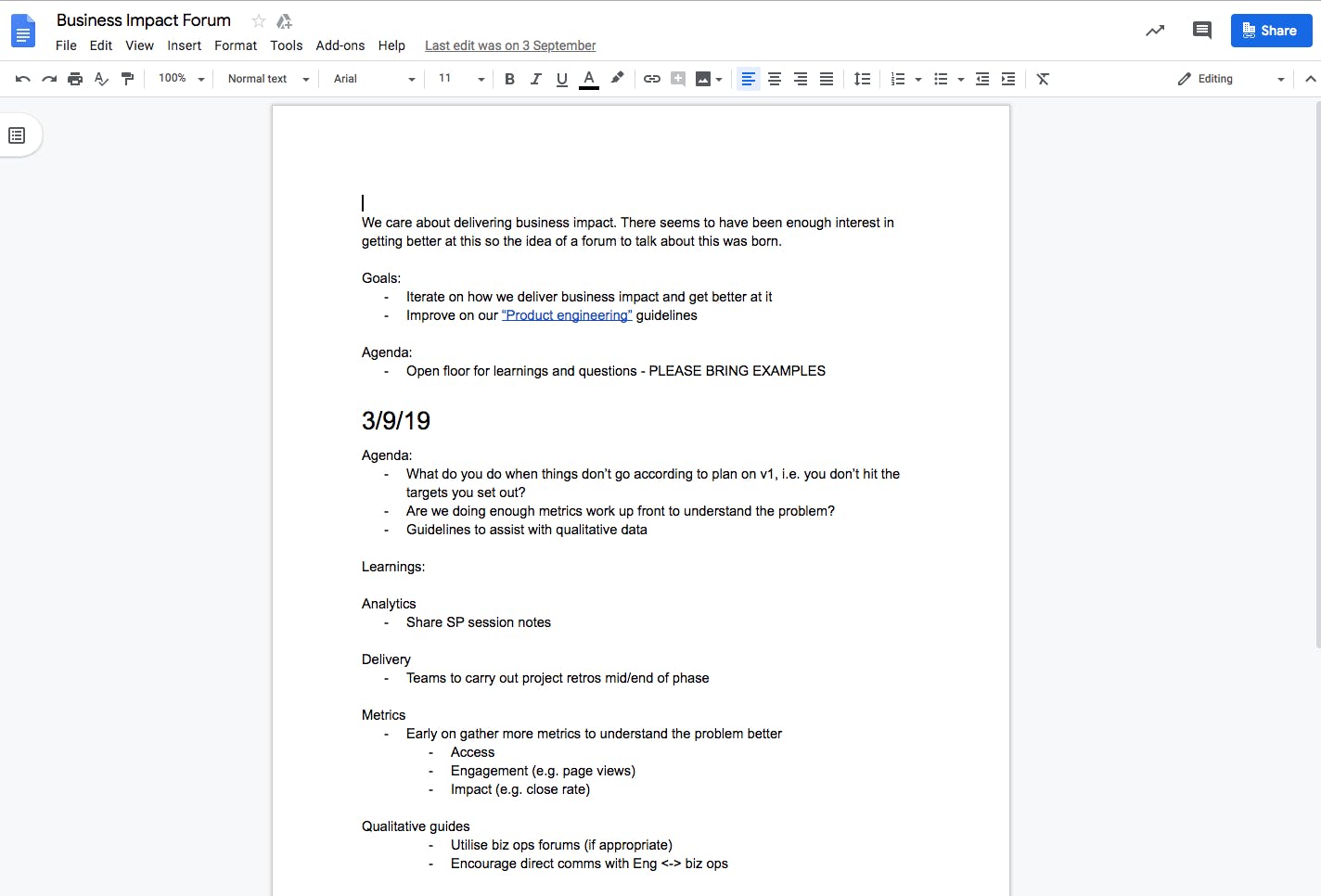
How to drive a 'Business Impact' culture
This follows on from a post I did recently on “Feature Leading” and how it helped me reach the next level. This article focuses on how we handle delivering impact as an Engineering/Product department as well as a Business.

At Nested we aim for optimal ROI (return-on-investment). We try to quantifiably demonstrate that we are heading towards our goal by using KPIs (key performance indicators; low-level targets which help achieve a greater goal). As everything we do aims to demonstrate its value-added, we seek out ways to help us improve how we do this.
We initially introduced the Feature Lead role to give engineers more input and ownership of a problem or feature. It is a set of considerations to help deliver a feature well and with high impact. However it has 2 main issues:
- Does not offer a way to share learnings and ideas around the business and teams
- The considerations are too static: what emphasis is there on the feature lead to update or follow the considerations? There is none really.
We sought out to address these by defining how we approach Impact together.
What do I mean by "Impact"?
“Business Impact” attempts to measure the consequence and significance of features or changes to the business. It is a high-level view which should connect to KPIs. An example is our close-rate (i.e. the number of users who decide to list their property with us). If we can prove that a feature has directly improved close rate then that would be defined as having a “very high impact”. It is contrast to user engagement, which is typically more product-level than impact-level (i.e. “are customers finding it useful?” is a different question to “has it actually helped close more customers?”)
I see the Feature Lead role as a path, and the destination is delivering high Business Impact.
We had several questions which we aimed to answer, such as;
- How could we as a business create an environment which would help us get better at achieving high impact?
- What is the ideal way to share any learnings and house discussions so that we can be impact-oriented together?
- What tools or processes could we introduce which would help us to keep impact-oriented?
Here are some of the methods we use, with a brief explanation on how and why we have adopted it.
1. Impact boards
This is a physical kanban board that each team has. It consists of 4 sections.
- Backlog
- In Progress
- Gathering metrics/feedback
- Validated, which consists of 2 sub-sections.
- Impact achieved! Move on
- Impact failed but with learnings. Move on

Each feature is added to this board as work begins on it, and this is reviewed once a week (usually on a Thursday, triggered by calendar reminders). As it isn’t digital it is harder to ignore or remove items without others noticing.
The aim is for Feature Leads to give an update on whether it has been answered or validated yet. The focus is not on the numbers, more on a status update. For example, “we are waiting for more users on X, so next week we should have a stronger idea on how it has performed”. Features which have moved into the final column do not need further updates.
The session serves to keep everyone updated but also keeps the lead accountable for following up.
2. Impact Forum and notes
This is a forum which meets once every 4-6 weeks. Everyone is invited from data, engineering, product and design etc but attendance is completely optional.
Typically each meeting starts by reviewing previous actions, an example of such an action is “person X to schedule a training session on subject Y”.
We set an item on the agenda a couple of days beforehand, for example “What do you do when things don’t go according to plan on v1, i.e. you don’t hit the targets you set out?”. The item is then opened to the floor for discussion. This example was a recent item which produced some interesting ideas.
Some of the insights and learnings during the discussion are stored inside an “Impact Forum notes” Google document (see screenshot below) which everyone has access to, along with actions (if any) for the following meeting.

Often someone will come to the forum with a question they would like answered or discussed, so after the actions are reviewed and the initial agenda item is discussed the floor is finally opened up to these.
The Forum has proved an incredibly useful session to share any learnings but also to iteratively improve how we deliver business impact.
3. "All hands" metrics section
At Nested we have an EPD (engineering, product and design) “all hands”. A meeting every 2 weeks which everyone attends. The aim is to review EPD KPI’s as well as any recent updates or incidents.
We decided to add a section in here for “Business Impact metrics”. A couple of days beforehand, each Lead is encouraged to add a single slide on their feature (if there is anything to update) which they present during the meeting. Each slide typically includes a couple of bullet points and a graph or 2. See below example of a typical slide presented.

It has proved a great way to keep the business updated on a product-level as well as impact-level i.e. How has it effected our close rate? It also serves to incentivise the Lead to keep on top of their feature’s impact and think about it as early as possible.
Do it for yourselves
The above techniques that we utilise have all evolved from discussions. We try different things for different reasons and see what sticks. All three of the above did not start in the current form.
For example the section in the “all hands” was initially a small update done during feature demos (which happen on a Friday afternoon), but we decided it was not giving the “impact updates” enough time or attention there.
Another example was the forum, it was initially just going to be a small meeting with feature leads every week, but we realised the value of including more of the business (for better input and sharing) and allowing more time between meets, so there was more to discuss.
The idea is to find what works for you, to not be afraid to fail and invest time and energy in it. We retrospectively review these processes as well as gather feedback often which really helps direct us. Who knows what format they will have in the future, but the important aspect is that we are getting better at delivering impactful work.
I am very thankful there is such a great culture at Nested, which always encourages people to be pro-active, to identify issues for themselves and ensure they are given the attention they will require.
Please feel free to get in touch about your experiences, we would love to hear about them.